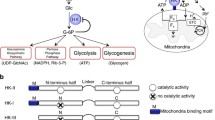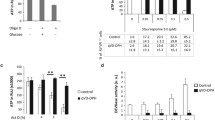Abstract
The transport and metabolism of glucose modify programmed cell death in a number of different cell types. This review presents three cell death paradigms that link a decrease in glucose transport to apoptosis. Although these pathways overlap, the glucose-dependent stimuli that trigger cell death differ. These paradigms include glucose deprivation-induced ATP depletion and stimulation of the mitochondrial death pathway cascade; glucose deprivation-induced oxidative stress and triggering of Bax-associated events including the JNK/MAPK signalling pathways; and finally hypoglycemia-regulated expression of HIF-1α, stabilization of p53 leading to an increase in p53-associated apoptosis. Several examples of each paradigm are presented. Future studies of glucose transport-associated apoptotic events will allow better understanding of the role of cellular metabolism in programmed cell death.
Similar content being viewed by others
References
Berridge MV, Tan AS, McCoy KD, Kansara M, Rudert F. CD95 (Fas/Apo-1)-induced Apoptosis results in loss of glucose transporter function. J Immunology 1996; 156: 4092–4099.
Kan O, Baldwin SA, Whetton AD. Apoptosis is regulated by the rate of glucose transport in an interleukin 3 dependent cell line. J Exp Med 1994; 180: 917–923.
Malhotra R, Brosius FC. Glucose uptake and glycolysis reduce hypoxia-induced apoptosis in cultured neonatal rat cardiac myocytes. J Biol Chem 1999; 274: 12567–12575.
Johnson EM, Deckwerth TL, Deshmukh M. Neuronal death in developmental models: possible implications in neuropathy. Brain Path 1996; 6: 397–409.
Li W, Liu X, He Z, Yanoff M, Jian B, Ye X. Expression of apoptosis regulatory genes by retinal pericytes after rapid glucose reduction. Invest Ophthalmol Vis Sci 1998; 39: 1535–1545.
Bialik S, Cryns VL, Drincic A, Miyata S, Wollowick AL, Srinivasan A, Klitsis RN. The mitochondrial apoptotic pathway is activated by serum and glucose deprivation in cardiac myocytes. Circ Res 1999; 85: 403–414.
Shim H, Chun YS, Lewis BC, Dang CV. A unique glucosedependent apoptotic pathway induced by c-myc. Proc Natl Acad Sci 1998; 95: 1511–1516.
Long X, Boluyt MO, Hipolito ML, Lundberg MS, Zheng JS, O'Neill L, Cirielli C, Lakatta EG, Crow MT. P53 and the hypoxia-induced apoptosis of cultured neonatal rat cardiac myocytes. J Clin Invest 1997; 99: 2635–2643.
Fujio Y, Kunisada K, Hirota H, Yamauchi-Takihara K, Kishimoto T. Signals through gp130 upregulate bcl-x gene expression via STAT1–binding cis-element in cardiac myocytes. J Clin Invest 1997; 99: 2898–2905.
Saikumar P, Dong Z, Patel Y, Hall K, Hopfer U, Weinber JM, Venkatachalam MA. Role of hypoxia induced Bax translocation and cytochrome c release in reoxygenation injury. Oncogene1998; 17: 3401–3415.
Kalaria RN, Harik SI. Reduced glucose transporter at the blood-brain barrier and in cerebral cortex in Alzheimer's disease. J Neurochem 1989; 53: 1083–1088.
Hoyer S. Abnormalities in brain glucose utilization and its impact on cellular and molecular mechanisms in sporadic dementia of Alzheimers type. Ann NY Acad Sci 1993; 695: 77–80.
Mark RJ, Pang Z, Geddes JW, Uchida K, Mattson MP. Amyloid beta-peptide impairs glucose transport in hippocampal and cortical neurons-involvement of membrane lipid peroxidation. J Neuroscience 1997; 17: 1046–1054.
Blanc EM, Toborek M, Mark RJ, Hennig B, Mattson MP. Amyloid beta-peptide induces cell monolayer albumin permeability, impairs glucose transport and induces apoptosis in vascular endothelial cells. J Neurochem 1997; 68: 1870–1881.
Keller JN, Pang Z, Geddes JW, Begley JG, Germeyer A, Waeg G, Mattson MP. Impairment of glucose and glutamate transport and induction of mitochondrial oxidative stress and dysfunction in synaptosomes by amyloid beta-peptide: role of the lipid peroxidation product 4–hydroxynonenal. J Neurochem1997; 69: 273–284.
Mattson MP, Guo AH, Geiger JD. Secreted form of amyloid precursor protein enhances basal glucose and glutamate transport and protects against oxidative impairment of glucose and glutamate transport in synaptosomes by a cyclic GMPmediated mechanism. J Neurochem 1999; 73: 532–537.
PedersenWA, Cashman NR, Mattson MP. The lipid peroxidation product 4–hydroxynonenal impairs glutamate and glucose transport and choline acetyltransferase activity in NSC-19 motor neuron cells. Exp Neurology 1999; 155: 1–10.
Kostic V, Jackson-Lewis V, de Bilbao F, Dubois-Daupin M, Przedborski S. Bcl-2: Prolonging life in a transgenic mouse model of familial amyotrophic lateral sclerosis. Science 1997; 277: 559–562.
Mandarino LJ, Finlayson J, Hassell JR. High glucose downregulated glucose transport activity in retinal capilllary pericytes but not endothelial cells. Invest Ophthalmol Vis Sci 1994; 35: 964–972.
Blackburn RV, Spitz DR, Liu X, Galoforo SS, Sim JE, Ridnour LA, Chen JC, Davis BH, Corry PM, Lee YJ. Metabolic oxidative stress activates signal transduction and gene expression during glucose deprivation in human tumor cells. Free Rad Biol Med 1999; 26: 419–430.
Lee YJ, Galoforo SS, Berns CM, Tong WP, Kim HRC, Corry PM. Glucose deprivation-induced cytotoxicity in drug resistant human breast carcinoma MCF-7/ADR cells: Role of c-myc and bcl-2 in apoptotic cell death. J Cell Sci 1997; 110: 681–686.
Shim H, Dolde C, Lewis BC, Wu CS, Dan G, Jungmann RA, Dall-Favera R, Dang CV. C-myc transactivation of LDH-A: implications for tumor metabolism and growth. Proc Natl Acad Sci 1997; 94: 6658–6663.
Dang CV, Lewis BC, Dolde C, Dang G, Shim H. Oncogenes in tumor metabolism, tumorigenesis, and apoptosis. J Bioenerg Biomembr 1997; 29: 345–354.
Deckwerth TL, Johnson EM. Temporal analysis of events associated with programmed cell death (apoptosis) of sympathetic neurons deprived of nerve growth factor. J Cell Biol 1993; 123: 1207–1222.
Deckwerth TL, Easton RM, Knudson CM, Korsmeyer SJ, Johnson EM Jr. Placement of the Bcl-2 family member BAX in the death pathway of sympathetic neurons activated by trophic factor deprivation. Exp Neurol 1998; 152: 150–162.
Miller TM, Moulder KL, Knudson CM, Creedon DJ, Deshmukh M, Korsmeyer SJ, Johnson EM Jr. Bax deletion further orders the cell death pathway in cerebellar granule cells and suggests a caspase-independent pathway to cell death. J Cell Biol 1997; 139: 205–217.
Greenlund LJS, Deckwerth TL, Johnson EM Jr. Superoxide dismutase delays neuronal apoptosis: a role for reactive oxygen species in programmed neuronal death. Neuron 1995; 14: 303–315.
Carmeliet P, Dor Y, Herbert J-M, Fukkumura D, Brusselmans K, Dewerchin M, et al. Role of HIF-1 in hypoxia-mediated apoptosis, cell proliferation and tumor angiogenesis. Nature 1998; 394: 485–490.
An WG, Kanekal M, Simon MC, Maltepe E, Blagosklonny MV, Mecker LM. Stabilization of wild-type p53 by hypoxiainducible factor 1®. Nature 1998; 392: 405–408.
Moley KH, Chi MM-Y, Mueckler MM. Maternal hyperglycemia alters glucose transport and utilization in mouse preimplantation embryos. American Journal of Physiology1998; 275: E38–47.
Moley KH, Chi MM-Y, CM Knudson, Korsmeyer SJ, Mueckler MM. Hyper glycemia induces apoptosis in pre-implantation embryos through cell death effector pathways. Nature Medicine 1998; 4: 1421–1424.
Author information
Authors and Affiliations
Rights and permissions
About this article
Cite this article
Moley, K.H., Mueckler, M.M. Glucose transport and apoptosis. Apoptosis 5, 99–105 (2000). https://doi.org/10.1023/A:1009697908332
Issue Date:
DOI: https://doi.org/10.1023/A:1009697908332




